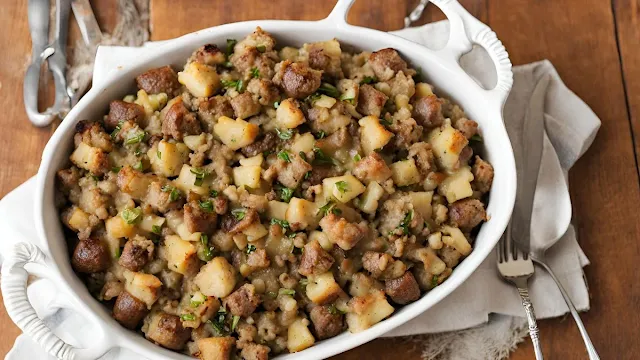Sausage Stuffing Recipe - Thanksgiving Stuffing
There's something incredibly satisfying about making your own sausages. From selecting the perfect blend of spices to mastering the art of stuffing, homemade sausage making is both a rewarding and delicious hobby. Whether you're a seasoned home cook or just starting out, this guide will walk you through the steps to create mouth-watering sausages right in your kitchen.
Ingredients and Tools
Ingredients
- 2 pounds of pork shoulder (or a mix of pork and beef)
- 1/2 pound of fatback (for that essential juiciness)
- 2 teaspoons of salt
- 1 teaspoon of black pepper
- 1 tablespoon of fennel seeds
- 1 teaspoon of paprika
- 1/2 teaspoon of garlic powder
- 1/4 cup of cold water
Tools
- A meat grinder or food processor (for grinding the meat)
- Sausage stuffer (manual or electric)
- Casings (natural or synthetic)
- Mixing bowls and measuring spoons
- Sharp knife and cutting board
Preparing the Meat Mixture
- Chop the Meat and Fat
Begin by chopping the pork shoulder and fat back into small, manageable pieces. This makes the grinding process smoother and ensures an even mix.
- Grind the Meat
Using your meat grinder or food processor, grind the meat and fat together. Aim for a coarse grind to start, then re-grind if you prefer a finer texture.
- Mix in Seasonings
In a large mixing bowl, combine the ground meat with salt, pepper, fennel seeds, paprika, and garlic powder. Add the cold water to help distribute the spices evenly and keep the mixture moist. Mix thoroughly until the spices are well incorporated.
Using a Sausage Stuffer
- Prepare the Casings
Rinse the casings under cold water to remove any salt. If you're using natural casings, soak them in warm water for about 30 minutes before use.
- Load the Sausage Stuffer
Attach the casing to the nozzle of your sausage stuffer. Make sure to leave a few inches hanging off the end to tie off later. Load the meat mixture into the stuffer's reservoir.
- Start Stuffing
Slowly turn the handle (or press the button) to push the meat mixture into the casing. Use one hand to guide the sausage as it fills, ensuring an even distribution. Don't overstuff, as the casing might burst.
- Twist into Links
Once you have a long sausage, twist it every few inches to create individual links. Alternatively, leave it as one long coil if you prefer.
Best Casings to Use
- Natural Casings
Made from animal intestines, these provide the best texture and flavor. They're available at butcher shops or online.
- Synthetic Casings
Often made from collagen, these are more uniform and easier to handle. They can be found at specialty kitchen stores or online retailers.
Storing and Cooking Your Sausages
Storage Tips
- Refrigerate
Store fresh sausages in the refrigerator for up to 3 days.
- Freeze
For longer storage, freeze sausages by placing them in a single layer on a baking sheet. Once frozen, transfer them to a freezer-safe bag or container. They’ll keep for up to 3 months.
Cooking Ideas
- Grill or Pan-Fry
Cook sausages over medium heat until they reach an internal temperature of 160°F.
- Roast
Bake sausages in a preheated oven at 350°F for 20-25 minutes.
- Incorporate into Dishes
Use your homemade sausages in pasta, stews, or casseroles for a burst of flavor.
Closing
Making your own sausages is a fun and rewarding experience that allows you to experiment with flavors and create something truly unique. We hope this guide inspires you to get started on your sausage-making adventure. Don't forget to share this post and tag us in your sausage-making creations!
Happy cooking,

